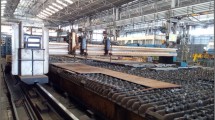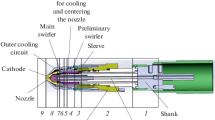Abstract
In this paper, we studied the characteristics of the plasma cutting for thick steel ship plate. In general, plasma cutting speed is faster than gas cutting speed. However, It is known that quality of plasma cutting is bad for thick plate 30 mm or more. And plasma cutting is difficult to cut steel plate for 50 mm or more. The purpose of this study was to find out the worsening cause of cutting quality for 30 mm or more thick plate cutting. This study observed the form of the cut and the metallic organization of cross section in the heat affected zone. We found that the flow of molten metal was influenced by the cutting conditions during plasma cutting through experiments. Also we were able to recognize the impact of the quality of the cut by the shape of the cut and HAZ depth.
Similar content being viewed by others
References
Lho, T. J. and Na, S. J., “Arc Efficiency and Kerf Width in Plasma Arc Cutting Process,” Journal of The Korean Welding & Joining Society, Vol. 5, No. 1, pp. 23–33, 1987.
Um, K. W. and Kim, D. J., “A Study on the plasma arc cutting phenomena of plate materials,” Journal of The Korean Welding & Joining Society, Vol. 9, No. 4, pp. 69–74, 1991.
Sohn, S. J. and Shin, J. G., “Simulation based design of an automated hull-piece manufacturing system,” Journal of the Society of Naval Architects of Korea, Vol. 36, No. 4, pp. 128–136, 1999.
Kim, I. C. and Kim, S. I., “A study on the cutting characteristics of ah36 steel plate under various cutting conditions,” Journal of The Korean Welding & Joining Society, Vol. 21, No. 2, pp. 3–8, 2003.
Kim, H. G., Shin, K. I., Park, J. H., Kim, S. C., and Kim, C. I., “Characteristics of plasma cut metal surfaces,” Journal of Industrial Science and Technology Institute, Vol. 14, No. 1, pp. 79–89, 2000.
Ku, J. M. and Kim, J. W., “A study of automatic tip-to-workpiece distance control system for plasma arc cutting,” Int. J. Precis. Eng. Manuf., Vol. 17, No. 7, pp. 132–140, 2000.
Kim, M. H. and Kim, S. I., “A study on the cutting surfaces in plasma cutting of ship thick plate,” International Conference of Manufacturing Technology Engineers, pp. 573–574, 2011.
Jeon, Y. and Lee, C. M., “Current research trend on laser assisted machining”, Int. J. Precis. Manuf., Vol. 13, No. 2, pp. 311–317, 2012.
Jeon, Y., Park, H., and Lee, C. M., “Current research trends in external energy assisted machining,” Int. J. Precis. Eng. Manuf., Vol. 14, No. 2, pp. 337–342, 2013.
Author information
Authors and Affiliations
Corresponding author
Rights and permissions
About this article
Cite this article
Kim, SI., Kim, MH. Evaluation of cutting characterization in plasma cutting of thick steel ship plates. Int. J. Precis. Eng. Manuf. 14, 1571–1575 (2013). https://doi.org/10.1007/s12541-013-0212-x
Received:
Accepted:
Published:
Issue Date:
DOI: https://doi.org/10.1007/s12541-013-0212-x




